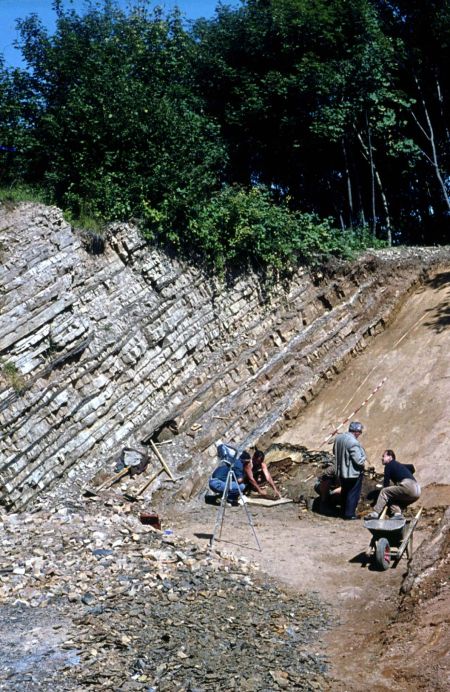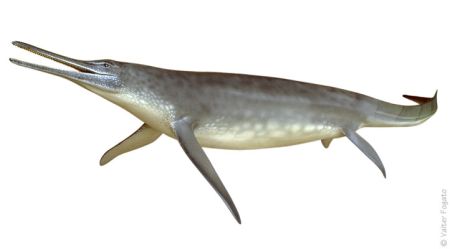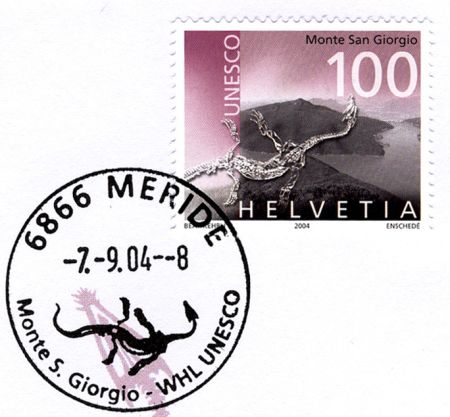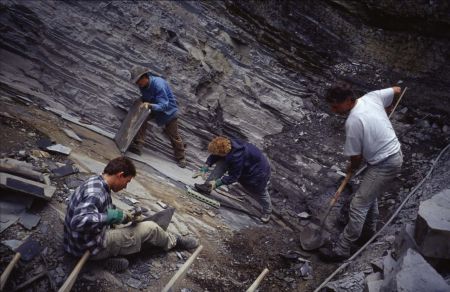The post-war period
Following a break during the Second World War, the research started again in Switzerland in 1950 under the direction of Emil Kuhn-Schnyder, a colleague and successor of Peyer. The new excavations, in collaboration with the Geologisch-Paläontologisches Institut der Universität Basel (Louis Vonderschmitt) at the Mirigioli locality between Serpiano and the summit of Monte San Giorgio, continued until 1968. Better known as "Point 902", the initial surface area of rock excavated was approximately 240 square meters, reduced to 90 square meters at the base of the 16 m thick vertical section of the Besano Formation, making this the most extensive and systematic excavation ever undertaken at Monte San Giorgio. In 1956, Emil Kuhn-Schnyder founded the Palaeontological Institute in Zurich to house the growing collection of specimens. In 1965, the Palaeontological Museum at the University of Zurich was opened, where the largest collection of fossils from Monte San Giorgio is kept to this day.
In 1973 Emil Kuhn-Schnyder, along with Hans Rieber, opened the first Museum of fossils in Meride, where a selection of original fossils and casts from the collection of Zurich were displayed. In 1983-1984, Hans Rieber organized another excavation in the Besano Formation, this time concentrating on the ammonoids and bivalves (specifically the daonelles). From 1976-2001, Hans Rieber also directed the continuing study of the extensive collection of fossils in Zurich.
Emil Kuhn-Schnyder (1905–1994) on the excavation Mirigioli or "Point 902" (photo PIMUZ, 1963)

On the Italian side of Monte San Giorgio, paleontological excavations were re-started in 1975 by the Museo Civico di Storia Naturale di Milano, under the direction of Giovanni Pinna and Giorgio Teruzzi, at Rio Ponticelli above Besano. Later excavations were at Sasso Caldo, also above Besano, where in 1993 a marine reptile of 6 m length named Besanosaurus leptorhynchus, the largest reptile so far known from Monte San Giorgio, was found. These excavations were also the last in the Besano Formation, mainly because research interests had changed and were focusing on the younger but less well-known fossil levels of the Meride Limestone (Cava inferiore, Cava superior and Cassina beds, and Kalkschieferzone).
Drawing of the skeleton of Besanosaurus leptorhynchus, alongside Giorgio Terruzzi, scientific leader of the excavations in Sasso Caldo over Besano. © Museo di Storia Naturale di Milano

Reconstruction of Besanosaurus leptorhynchus with a length of 6 m, © Museo di Storia Naturale di Milano (photo V. Fogato)

The first palaeontological investigations in the Meride Limestone actually date back to 1927 and were undertaken by Bernhard Peyer. In 1937, excavations in the Cava inferiore beds discovered the complete skeleton of the nothosaur Ceresiosaurus calcagnii that is still one of the most famous fossils from Monte San Giorgio. Today, this fossil is a symbol of Monte San Giorgio and is also depicted on a commemorative postage stamp. Emil Kuhn-Schnyder organized several further excavations in the Cassina beds between 1971 and 1975.
Stamp of the Swiss Post (2004) with Ceresiosaurus calcagnii

Since the early 1990's research on the Meride Limestone has been carried out by several institutions at different locations of Monte San Giorgio, all supported and co-financed by the Museo cantonale di storia naturale di Lugano. A group at the Dipartimento di Scienze della Terra dell’Università di Milano, led by Andrea Tintori, worked from 1990 to 2003 in the Kalkschieferzone, firstly at the locality of Ca' del Frate/Besnasca on the Italian side, north of Viggiù (in collaboration with the Museum of Induno Olona), and later near Meride along the gorge of Gaggiolo in Switzerland. From these excavations many new fish, rare reptiles, plants, small crustaceans and even the first fossil insects attributed to the genera Tintorina and Notocupes were recovered. Between 1994 and 2004, a group from the Paläontologisches Institut und Museum der Universität Zürich led by Heinz Furrer conducted major new excavations, mainly in the Cava inferiore and Cava superiore beds at Acqua del Ghiffo. They discovered numerous exceptionally preserved fossils of fish and marine reptiles, the latter including two juvenile Ceresiosaurus calcagnii and, notably, the relatively smaller Neusticosaurus. Extraordinary slabs with up to 20 skeletons preserved are now exhibited in the Museo cantonale di storia naturale di Lugano (N. pusillus) and in the Museo dei fossili del Monte San Giorgio in Meride (N. peyeri).
The Zurich University team working at Acqua del Ghiffo, directed by Heinz Furrer. (photo H. Furrer, 2001)





